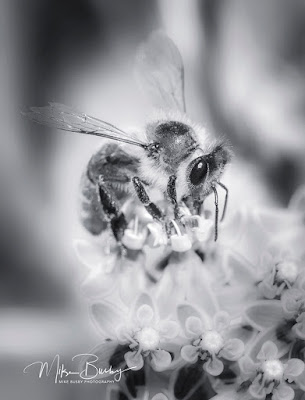Macro Photography by Mike Busby - Spokane Photographer, CPP
Macro Photography – With the Tamron 180mm Macro Lens.
The last few months have ushered in Spring, and it is insect shooting time with the macro lens. More specifically, photographing with the Tamron 180mm macro lens for Nikon and Canon. I purchased this lens several years ago as a fun lens for bugs. However, the lens is producing fantastic results, it is producing revenue, and it’s generating images that surpass professional standards.
This article is about the application of the lens and the techniques used to capture the images. All of the images were captured with a Nikon D810. To me, this lens has the quality of a good kit lens as put forth by the brand names. The lens sometimes hunts while focusing, but I am shooting very small and fast moving objects. The focusing is a minor irritation compared to the results that it gets, and the hunting diminishes the more you adjust to the feel of the lens.
 |
| Black and White Bee - 1/750th @ f8, ISO 400 - © 2016 Mike Busby Photography |
Depth of field is extraordinarily narrow when shooting macro. On “Black and White Bee,” one antenna is sharp, but the other is out of focus, and this is in the space of a couple of millimeters. Shooting for output is the first consideration of any photograph, and my goal is to produce 16”x20” quality prints — a 20 to 40 times enlargement of the original subject. Shooting at 1/750th sec at f8, ISO 400, has provided the best balance for capturing and printing the images. Increase the aperture and there is not enough light. Slow the shutter speed and motion blur creeps into the image. Up the ISO and the image begins to degrade – especially if one is using a tight crop. I use these setting with confidence, and I know if I capture the insect about the size of a nickel on screen, then I’m nearing my output goals.
This is a conventional image converted to black and white with brightness and contrast adjustments, The front flowers were softened to accentuate the sharpness of the bee. However, the image itself was not sharpened – it all came from the lens.
 |
| Flight - 1/750th @ f8, ISO 400 - © 2016 Mike Busby Photography |
All my shots are of live bugs in the field. They aren’t frozen, they aren’t dead, and they aren’t coated in hairspray. However, they do move faster than you can process. If you see a pose, then it’s too late. The bee has already moved by the time your brain registers what you had seen. This means you’re shooting a lot and you’re shooting to anticipate movement. Yes, there are a lot of shots that end up in the trash bin, but the technique works and all of the good shots are authentic. The best approach has been keeping the autofocus on the face of the insect and letting the lens and camera do the rest.
This is almost a full frame shot, and there is a ton of depth of field. This is an example of freehand photo-stacking. Many macro photographers do not use autofocus — they simply move the camera closer or further from the subject and the focus changes with each movement. In this case, I focused on the front snout, and then incrementally moved through the dragonfly while taken continuous photos. The images were layered into Photoshop, and then just the sharp areas were brought forth into the final image. This image was actually five photos layered for sharpness. This technique can be used on any static image in the field.
 |
| In the Green - 1/100th @ f6.7, ISO 400 - © 2017 Mike Busby Photographer |
I am frequently asked how I get the bugs to pose. There is no magic — just follow the insect and interesting compositions will develop. This grasshopper was moving about the plant when this image came into view. Once realized, it’s just a matter of keeping the autofocus on the eyes while taking shots.
We tend to move about and look for images, but my best images have come from finding a spot and letting interesting things develop. Patience is just as important as technique and equipment when photographing in the field.
I use to purchase only name brand lenses for name brand cameras. However, the quality of the third party lenses has improved throughout the years. I am unable to compare the Tamron 180mm Macro to the Nikon equivalent, but I know the Tamron is $1,200 less, and it does absolutely everything I need it to do.
Thanks for reading!
Mike Busby
Mike Busby Photographer
(509) 995-2954
Busbywc.com

Comments
Post a Comment